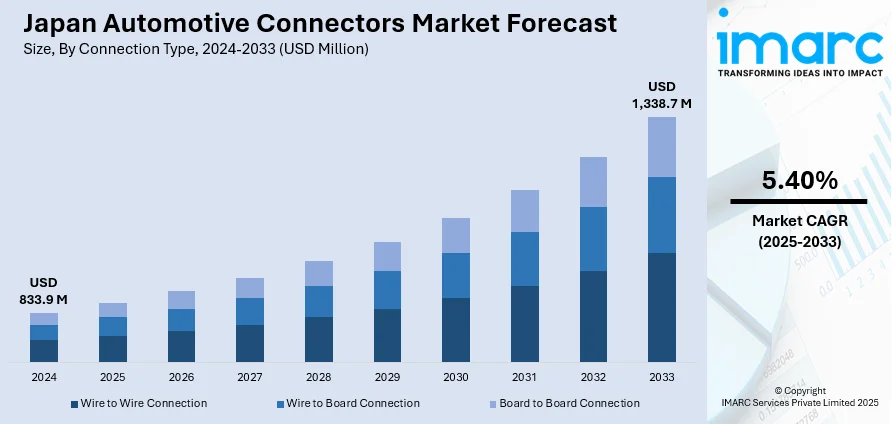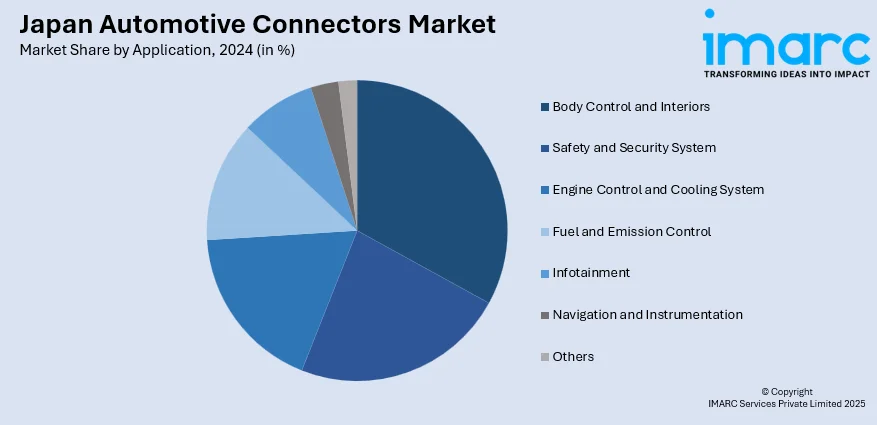
Japan Automotive Connectors Market Size, Share, Trends and Forecast by Connection Type, Connector Type, System Type, Vehicle Type, Application, and Region, 2025-2033
Japan Automotive Connectors Market Overview:
The Japan automotive connectors market size reached USD 833.9 Million in 2024. Looking forward, IMARC Group expects the market to reach USD 1,338.7 Million by 2033, exhibiting a growth rate (CAGR) of 5.40% during 2025-2033. The market is advancing with growing demand for high-speed data transfer, optical connectivity, and design efficiency. Developments in smart vehicles and EVs, along with streamlined production efforts, continue to push innovation and integration. These factors are contributing to the steady rise in the market growth, as manufacturers prioritize compact, durable, and high-performance connectors.
|
Report Attribute
|
Key Statistics
|
|---|---|
|
Base Year
|
2024
|
|
Forecast Years
|
2025-2033
|
|
Historical Years
|
2019-2024
|
| Market Size in 2024 | USD 833.9 Million |
| Market Forecast in 2033 | USD 1,338.7 Million |
| Market Growth Rate 2025-2033 | 5.40% |
Japan Automotive Connectors Market Trends:
Shift Toward High-Speed Data Connectivity
Japan’s automotive connectors market is increasingly focusing on supporting higher data transmission speeds due to the growing integration of advanced electronics in vehicles. As modern vehicles adopt features like autonomous driving, in-vehicle infotainment, and advanced driver assistance systems, there is a rising need for connectors that can handle large volumes of data efficiently and reliably. In this context, innovation in optical connectivity has gained momentum, as it provides the speed and stability required for such applications. These technologies also help reduce signal loss and electromagnetic interference, which are critical issues in high-speed automotive networks. In September 2024, Hirose Electric and AIO Core formed a capital and business alliance to co-develop high-performance active optical connectors. The collaboration integrated quantum dot laser-based silicon photonics with Hirose’s packaging and modularization technologies, aiming to deliver faster, high-capacity connectors tailored for the automotive and medical sectors, thereby supporting automotive connector market growth. This development reflects a growing shift toward optical components, especially in applications where data-intensive processing is essential. With more vehicles requiring faster communication between components, demand for high-speed connectors is expected to increase significantly. Companies investing in such innovations are likely to gain a competitive advantage as automakers prioritize digital systems and network-driven architectures in upcoming vehicle models.

Operational Streamlining to Boost Efficiency
As Japan’s automotive sector embraces faster innovation cycles, companies are reorganizing internal operations to enhance efficiency in product development. This trend is evident in how connector manufacturers are aligning production, design, and administration under unified structures to reduce time-to-market. These changes also support better resource allocation, improved cross-functional communication, and faster problem-solving—all essential for staying responsive to changing automotive needs. In March 2025, Kyocera announced the integration of its two Yokohama offices into a single administrative unit while continuing to develop automotive-related products and connector solutions. This integration brought together nearly 1,100 employees under a coordinated setup, helping streamline operations across design, manufacturing, and support functions. With both locations retaining their addresses, the move focused on improving internal workflows rather than geographical consolidation. As other companies follow suit, the trend of internal consolidation is likely to become more prominent in Japan’s automotive connectors market. These efforts strengthen companies’ capabilities to deliver consistent, high-quality connector products suited for the evolving needs of electric and intelligent vehicles. Based on these operational shifts and ongoing technological advancements, the automotive connectors market forecast points to sustained growth driven by efficiency, adaptability, and product innovation.
Japan Automotive Connectors Market Segmentation:
IMARC Group provides an analysis of the key trends in each segment of the market, along with forecasts at the country and regional level for 2025-2033. Our report has categorized the market based on connection type, connector type, system type, vehicle type, and application.
Connection Type Insights:
- Wire to Wire Connection
- Wire to Board Connection
- Board to Board Connection
A detailed breakup and analysis of the market based on the connection type have also been provided in the report. This includes wire to wire connection, wire to board connection, and board to board connection.
Connector Type Insights:
- PCB Connectors
- IC Connectors
- RF Connectors
- Fiber Optic Connectors
- Others
A detailed breakup and analysis of the market based on the connector type have also been provided in the report. This includes PCB connectors, IC connectors, RF connectors, fiber optic connectors, and others.
System Type Insights:
- Sealed Connector System
- Unsealed Connector System
As per the automotive connectors market outlook, a detailed breakup and analysis of the market based on the system type have also been provided in the report. This includes sealed connector system and unsealed connector system.
Vehicle Type Insights:
- Passenger Cars
- Commercial Vehicles
- Light Commercial Vehicles
- Heavy Commercial Vehicles,
- Electric Vehicles
A detailed breakup and analysis of the market based on the vehicle type have also been provided in the report. This includes passenger cars, commercial vehicles ( light commercial vehicles, heavy commercial vehicles), and electric vehicles.
Application Insights:

- Body Control and Interiors
- Safety and Security System
- Engine Control and Cooling System
- Fuel and Emission Control
- Infotainment
- Navigation and Instrumentation
- Others
A detailed breakup and analysis of the market based on the application have also been provided in the report. This includes body control and interiors, safety and security system, engine control and cooling system, fuel and emission control, infotainment, navigation and instrumentation, and others.
Regional Insights:
- Kanto Region
- Kansai/Kinki Region
- Central/ Chubu Region
- Kyushu-Okinawa Region
- Tohoku Region
- Chugoku Region
- Hokkaido Region
- Shikoku Region
The report has also provided a comprehensive analysis of all the major regional markets, which include Kanto Region, Kansai/Kinki Region, Central/ Chubu Region, Kyushu-Okinawa Region, Tohoku Region, Chugoku Region, Hokkaido Region, and Shikoku Region.
Competitive Landscape:
The market research report has also provided a comprehensive analysis of the competitive landscape. Competitive analysis such as market structure, key player positioning, top winning strategies, competitive dashboard, and company evaluation quadrant has been covered in the report. Also, detailed profiles of all major companies have been provided.
Japan Automotive Connectors Market News:
- March 2025: DENSO became the first Japan-based Business Application Provider to receive Catena-X EcoPass certification, enabling secure data exchange for Digital Product Passports. This advanced traceability and compliance for automotive connectors are boosting their role in circular manufacturing and regulatory-aligned supply chains across Europe.
- February 2025: NTT Communications became Japan’s first certified Catena-X onboarding service provider, enabling secure integration into the global automotive data ecosystem. This enhanced data collaboration and compliance readiness for automotive connectors improve international traceability, interoperability, and supplier connectivity within Japan’s automotive value chain.
Japan Automotive Connectors Market Report Coverage:
| Report Features | Details |
|---|---|
| Base Year of the Analysis | 2024 |
| Historical Period | 2019-2024 |
| Forecast Period | 2025-2033 |
| Units | Million USD |
| Scope of the Report |
Exploration of Historical Trends and Market Outlook, Industry Catalysts and Challenges, Segment-Wise Historical and Future Market Assessment:
|
| Connection Types Covered | Wire to Wire Connection, Wire to Board Connection, Board to Board Connection |
| Connector Types Covered | PCB Connectors, IC Connectors, RF Connectors, Fiber Optic Connectors, Others |
| System Types Covered | Sealed Connector System, Unsealed Connector System |
| Vehicle Types Covered |
|
| Applications Covered | Body Control and Interiors, Safety and Security System, Engine Control and Cooling System, Fuel and Emission Control, Infotainment, Navigation and Instrumentation, Others |
| Regions Covered | Kanto Region, Kansai/Kinki Region, Central/ Chubu Region, Kyushu-Okinawa Region, Tohoku Region, Chugoku Region, Hokkaido Region, Shikoku Region |
| Customization Scope | 10% Free Customization |
| Post-Sale Analyst Support | 10-12 Weeks |
| Delivery Format | PDF and Excel through Email (We can also provide the editable version of the report in PPT/Word format on special request) |
Key Questions Answered in This Report:
- How has the Japan automotive connectors market performed so far and how will it perform in the coming years?
- What is the breakup of the Japan automotive connectors market on the basis of connection type?
- What is the breakup of the Japan automotive connectors market on the basis of connector type?
- What is the breakup of the Japan automotive connectors market on the basis of system type?
- What is the breakup of the Japan automotive connectors market on the basis of vehicle type?
- What is the breakup of the Japan automotive connectors market on the basis of application?
- What is the breakup of the Japan automotive connectors market on the basis of region?
- What are the various stages in the value chain of the Japan automotive connectors market?
- What are the key driving factors and challenges in the Japan automotive connectors market?
- What is the structure of the Japan automotive connectors market and who are the key players?
- What is the degree of competition in the Japan automotive connectors market?
Key Benefits for Stakeholders:
- IMARC’s industry report offers a comprehensive quantitative analysis of various market segments, historical and current market trends, market forecasts, and dynamics of the Japan automotive connectors market from 2019-2033.
- The research report provides the latest information on the market drivers, challenges, and opportunities in the Japan automotive connectors market.
- Porter's five forces analysis assist stakeholders in assessing the impact of new entrants, competitive rivalry, supplier power, buyer power, and the threat of substitution. It helps stakeholders to analyze the level of competition within the Japan automotive connectors industry and its attractiveness.
- Competitive landscape allows stakeholders to understand their competitive environment and provides an insight into the current positions of key players in the market.
Need more help?
- Speak to our experienced analysts for insights on the current market scenarios.
- Include additional segments and countries to customize the report as per your requirement.
- Gain an unparalleled competitive advantage in your domain by understanding how to utilize the report and positively impacting your operations and revenue.
- For further assistance, please connect with our analysts.
 Request Customization
Request Customization
 Speak to an Analyst
Speak to an Analyst
 Request Brochure
Request Brochure
 Inquire Before Buying
Inquire Before Buying




.webp)




.webp)












